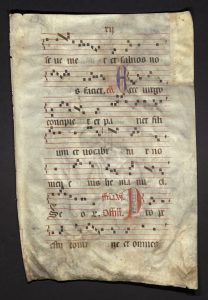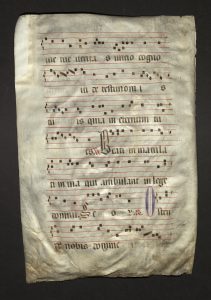Tags
13th century, abbreviations, Advent, altar, angel, Christ, clefs, climacus, commentary, custos, Emmanuel, Feast of the Annunciation of the Blessed Virgin Mary, fragment, Gregorian, Hebrew, hymn, illuminated, Isaiah, Italy, James Svendsen, Joseph, Latin, Lord, manuscript, Marriott Library, Mary, mass, Matthew, melisma, Middle Ages, neumes, New Testament, New York City, offertory, Old Testament, prophecy, punctum, qualism, readings, rests, Spain, St. Jerome, The University of Utah, transcription, translation, vellum, Vulgate

(ip)se veniet et salvos no-
s faciet. Co. ecce virgo
concipiet et pariet fili-
um et vocabitur no-
men eius hemanuel.
Off(ertoriu)m prope
es tu domine et omnes
He himself shall come and shall
make us saved. Behold a virgin
shall conceive and bear a son
and his name shall be
called Emmanuel. You are near, O Lord, and all
This page made of vellum (prepared calfskin, sheepskin or goatskin) was produced in the late Middle Ages, probably between the 13th and 15th centuries in Italy or Spain. It was purchased in New York City in 1974 for $25 by Professor James Svendsen, who donated it to the University of Utah Marriott Library in 2018. Dr. Svendsen provided the transcription, translation and commentary.
“The texts from the Old Testament are written in the Latin of the 14th c. Vulgate attributed to St. Jerome. They utilize the musical notation of Gregorian Chant with two clefs (fa/do), rests, custos, neumes etc. The most frequent neumes (names of notes sung on a single syllable) are the punctum, melisma, qualism, climacus etc. The five-line staff & custos (the Latin word for “guard” and a small note at the end of a line indicating the next note) are products of 13th century Italy, replacing the earlier four-line staff, and provide a terminus post quem for the manuscript. There are four illuminated letters (E, P, B, O) at the beginning of initial words. The abbreviations CO. (for collectum) and OFFM. (for offertorium) indicate when the hymns would be sung during the mass: the collect before the readings and the offertory when gifts are brought to the altar.
These particular hymns were sung during the mass on the 4th Sunday of Advent and on March 25, the Feast of the Annunciation of the Blessed Virgin Mary. The first two relate the prophecy of Isaiah and thus emphasize the main theme of Advent, a time preparing for the birth of the Christ child, who is called Emmanuel meaning “God with us” in Hebrew. The prophecy in Isaiah 7, 14 is fulfilled in the New Testament when the angel of the Lord appears to Joseph and explains that Mary has conceived and will bear a son (Matthew 1, 21-23).”
We are grateful to Dr. Svenson for this wonderful gift.

Viae tuae veritas
initio cogno-
vi te de testimoniis
tuis quia in eternum tu
es. V(ersus). beati immacula-
ti in via qui ambulant in lege
domini r(esponsum). Osten-
de nobis domine (misericordiam tuam)
your ways are truth.
From the beginning I knew
you from your testimonies
that you are eternal. Blessed are the immaculate
on the way who walk in the law
of the Lord. Show
us, O Lord, (your mercy)…

You must be logged in to post a comment.